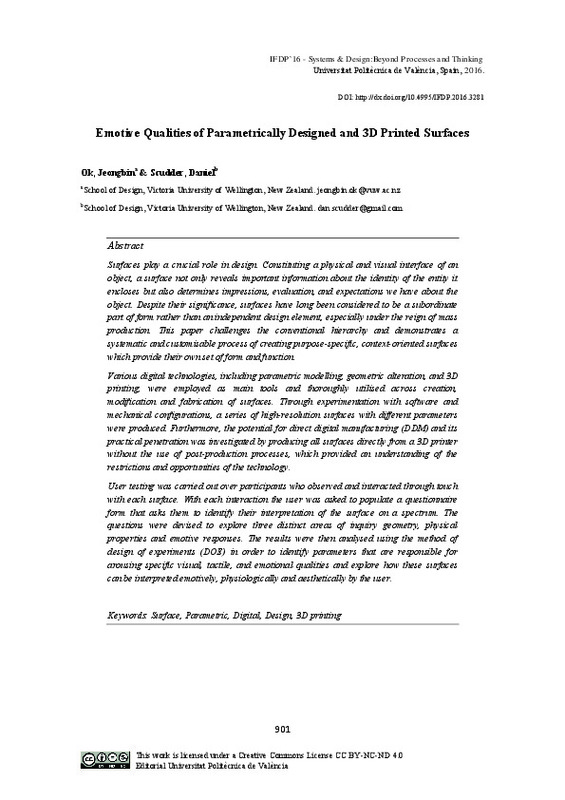JavaScript is disabled for your browser. Some features of this site may not work without it.
Buscar en RiuNet
Listar
Mi cuenta
Estadísticas
Ayuda RiuNet
Admin. UPV
Emotive qualities of parametrically designed and 3D printed surfaces
Mostrar el registro sencillo del ítem
Ficheros en el ítem
| dc.contributor.author | Ok, Jeongbin
|
es_ES |
| dc.contributor.author | Scudder, Daniel
|
es_ES |
| dc.date.accessioned | 2017-09-20T07:34:10Z | |
| dc.date.available | 2017-09-20T07:34:10Z | |
| dc.date.issued | 2016-10-27 | |
| dc.identifier.isbn | 9788490484401 | |
| dc.identifier.uri | http://hdl.handle.net/10251/87572 | |
| dc.description.abstract | [EN] Surfaces play a crucial role in design. Constituting a physical and visual interface of an object, a surface not only reveals important information about the identity of the entity it encloses but also determines impressions, evaluation, and expectations we have about the object. Despite their significance, surfaces have long been considered to be a subordinate part of form rather than an independent design element, especially under the reign of mass production. This paper challenges the conventional hierarchy and demonstrates a systematic and customisable process of creating purpose-specific, context-oriented surfaces which provide their own set of form and function. Various digital technologies, including parametric modelling, geometric alteration, and 3D printing, were employed as main tools and thoroughly utilised across creation, modification and fabrication of surfaces. Through experimentation with software and mechanical configurations, a series of high-resolution surfaces with different parameters were produced. Furthermore, the potential for direct digital manufacturing (DDM) and its practical penetration was investigated by producing all surfaces directly from a 3D printer without the use of post-production processes, which provided an understanding of the restrictions and opportunities of the technology. User testing was carried out over participants who observed and interacted through touch with each surface. With each interaction the user was asked to populate a questionnaire form that asks them to identify their interpretation of the surface on a spectrum. The questions were devised to explore three distinct areas of inquiry geometry, physical properties and emotive responses. The results were then analysed using the method of design of experiments (DOE) in order to identify parameters that are responsible for arousing specific visual, tactile, and emotional qualities and explore how these surfaces can be interpreted emotively, physiologically and aesthetically by the user. | es_ES |
| dc.format.extent | 21 | es_ES |
| dc.language | Inglés | es_ES |
| dc.publisher | Editorial Universitat Politècnica de València | es_ES |
| dc.relation.ispartof | Systems&design:beyond processes and thinking | es_ES |
| dc.rights | Reconocimiento - No comercial - Sin obra derivada (by-nc-nd) | es_ES |
| dc.subject | Surface | es_ES |
| dc.subject | Parametric | es_ES |
| dc.subject | Digital | es_ES |
| dc.subject | Design | es_ES |
| dc.subject | 3D printing | es_ES |
| dc.title | Emotive qualities of parametrically designed and 3D printed surfaces | es_ES |
| dc.type | Capítulo de libro | es_ES |
| dc.type | Comunicación en congreso | es_ES |
| dc.identifier.doi | 10.4995/IFDP.2015.3281 | |
| dc.rights.accessRights | Abierto | es_ES |
| dc.description.bibliographicCitation | Ok, J.; Scudder, D. (2016). Emotive qualities of parametrically designed and 3D printed surfaces. En Systems&design:beyond processes and thinking. Editorial Universitat Politècnica de València. 901-921. https://doi.org/10.4995/IFDP.2015.3281 | es_ES |
| dc.description.accrualMethod | OCS | es_ES |
| dc.relation.conferencename | Systems & Design: Beyond Processes and Thinking | es_ES |
| dc.relation.conferencedate | June 22-24,2016 | es_ES |
| dc.relation.conferenceplace | Valencia, Spain | es_ES |
| dc.relation.publisherversion | http://ocs.editorial.upv.es/index.php/IFDP/IFDP/paper/view/3281 | es_ES |
| dc.description.upvformatpinicio | 901 | es_ES |
| dc.description.upvformatpfin | 921 | es_ES |
| dc.type.version | info:eu-repo/semantics/publishedVersion | es_ES |
| dc.relation.pasarela | OCS\3281 | es_ES |








